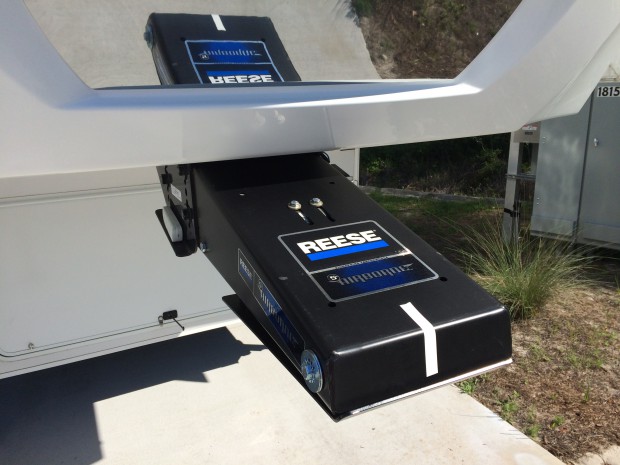
With a fifth-wheel trailer there are two components in the truck-to-trailer connection. One is the truck mounted fifth-wheel hitch and the second is the trailer half of the fifth-wheel connection equation, the pin box. The most important characteristic of the pin box is structural integrity, creating a strong connection from the trailer frame to the kingpin which connects to the truck frame mounted fifth-wheel hitch.
While we expect or even enjoy the bucking and jerky ride of a roller coaster, that type of ride is the last thing you want to experience when towing a fifth-wheel trailer. The vertical and longitudinal forces involved with a 14-18k trailer are great and can cause accelerated wear or even damage to the truck drivetrain, the trailer frame or even the appliances and household goods within the trailer.
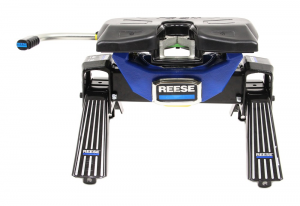
Our truck mounted fifth-wheel hitch, a Reese Titan 20, has vibration dampener bushings to somewhat lessen and minimize rattle and noise but its ability to do so is limited. Since we’re full time RV’ers hoping to travel thousands of miles we decided to go beyond the dampening abilities of the hitch and address the unforgiving rigidness of a standard pin box.
Several companies manufacture premium pin box designs which ensure the strength and integrity but also addresses both the horizontal and longitudinal towing forces. These pin boxes are direct replacements for the standard fixed pin box and each has advantages and fans. After much research I decided on a Reese 5th Airborne pin box because it had good functional users reviews and the airbag suspension and shock absorber are inside the unit protected from the elements. I also liked the idea of both a Reese hitch and pin box combination.
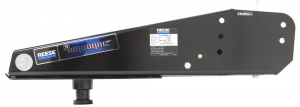
The 5th Airborne premium is a air-ride coupler with a built in shock absorbing design. It acts as a buffer between the tow vehicle and the trailer, minimizing the challenges in the road. This significantly reduces the negative impact of vertical shock and longitudinal chucking. The 5th Airborne does more than improve the ride; it protects our investments by relieving stress on the trailer’s frame, cabinets, mechanicals, and support mechanisms. Reduced vibration also saves contents. Furniture, appliances, TVs, computers, dishes, glassware and other fragile items stay in their places. Bonnie and I may also benefit from reduced fatigue and the improved safety provided by a smoother ride.
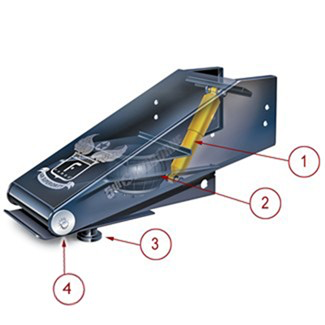 5th Airborne Premium Fifth Wheel Air-Ride Coupler
5th Airborne Premium Fifth Wheel Air-Ride Coupler
1. Rear mounted, heavy-duty shock absorber
2. Enclosed air spring also absorbs shock
3. King pin – connects to the fifth wheel trailer hitch in the truck bed
4. Pivot point – allows king pin to move up and down. Image credit: etrailer
Since we were staying in Carrabelle, FL, for a month it was a good opportunity to do the pin box replacement myself. I ordered the 5th Airborne Pin Box online from etrailer and it was delivered to the RV resort within 5 working days — with free shipping even.
On our trailer, and many others, the pin box was secured with eight 5/8 inch bolts, four on each side. These bolts are torqued to at least 150 lb-ft and require considerable effort to loosen the first time — especially if, like me, you run into a bolt which seems to be cross threaded. A long handled breaker bar will be needed and an impact driver could also come in handy if you have one. The new pin box is heavier then the original one and will easily weight over a hundred pounds so you’ll need either to have someone help lift it or use a lift of some kind such as I did — a motorcycle scissor jack to raise and lower the pin boxes from a truck tailgate.
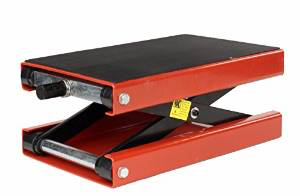
Here are the steps I took for installing the replacement pin box. Be sure and check for installation instructions for your own model of pin box:
- Measure from the old pin box to the ground in the position of the pin so you can be sure and get the new pin box installed at the same position. This ensures it will not change the truck to trailer height and towing position;
- Remove the trailer breakaway switch from the old pin box. This is usually a single screw;
- Break loose the eight bolts holding the old pin box in place. I did this before positioning the truck to give me more room to work;
- Lower the tailgate and back your truck so that the tailgate is directly under the pin box. Be sure and leave yourself as much room as possible to work;
- Place the scissor jack stand on the tailgate and under the old pin box and raise it until it can support the old pin box weight;
- Remove the eight retaining bolts;
- Lower the old pin box and then move it to one side;
- Place the new pin box on the lowered scissor jack in the correct position to be installed;
- With the scissor jack raise the new pin box into position aligning the bolt holes to the same position as the old pin box. It is easier to if you align and install the rear bolts first;
- Install and hand tighten the bolts firmly;
- Lower the scissor jack and move the truck out of the way;
- Check the measurement from the new pin box to the ground to confirm that it’s the same or very nearly the same height as the old pin box. If not you may have to use different mounting holes then the old pin box;
- Using a torque wrench, torque the bolts to the specifications provided in the instructions for your pin box;
- Drill a hole and mount the trailer breakaway switch on your new pin box in the same position as on the old pin box; and
- Stand back and admire your handy work!
The only thing I have left is to experience the difference the new premium pin box will make while towing. That will have to wait until we depart in a couple of weeks but I expect a noticeable difference.

Wow! I am impressed with all this new knowledge you are gaining with the new lifestyle. Feels like it’d be way over my head. But, it is amazing how detailed you are capable of gaining. Of course maybe Bonnie is doing all this while you watch. :-) I hope this does the trick for you.
Well thanks, Monte. It’s somewhat like the old proverb, “Necessity is the mother of invention.” In my case it’s, “When you have the need to know something you’ll learn it.”
Nope, not a chance Bonnie’s doing this. Her role is clearly defined — when she hears a loud noise she yells, “Are you all right?” and if I reply positively in a timely manner I get to continue my work. So far it’s worked out well. :-)